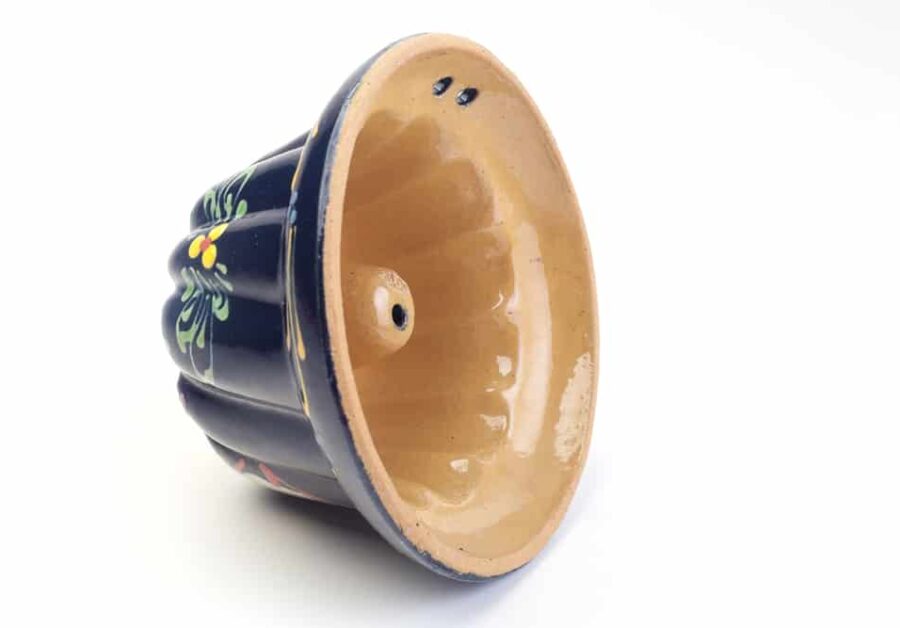The next time you take a bite of out of your favorite bundt cake recipe, I can guarantee you’ll never look at that scrumptious dessert quite the same way.
Why?
Because if it weren’t for another cake that you’ve probably never heard of, you might not even be able to enjoy this favorite American pastime of a dessert.
The mystery cake I am referring to is known as a Kugelhopf (pronounced koo-guhl-hoff) cake and it’s what the Kugelhopf pan is used to make.
But what is a Kugelhopf pan and where did it come from?
A Kugelhopf pan is used to make a circular, tall cake that originated in the Alsace region of France. Resembling modern bundt cakes, traditional Kugelhopf recipes are made with a sweet, yeasty dough that might also contain raisins, almonds and citrus zest, among other ingredients. Historically, Kugelhopf pans were made of earthenware, but today’s pans are made of non-stick metals or silicone molds.
Origins of the Kugelhopf Pan
Although the exact origin of the Kugelhopf pan is not entirely clear but it is largely believed to have its roots in France, specifically the Alsace region.
The term Gugel is the German word for hood, often pointed in shape and is thought to be derived from Latin. Recipes from the late 1500s describe a “hat cake” in reference to the final shape the dessert took once it was made. This lead some to conclude that it was designed to resemble styles of hats prevalent during medieval times.
Although Kugelhopf is the common term used to describe the modern version of the pan, other known historical spellings for it include Gugelhopf, Guglhupf and Kugelhupf.
| Name | Origin | Etymology | Historical Spellings |
|---|---|---|---|
| Kugelhopf Pan | France, specifically the Alsace region | Derived from German word “hood” and Latin | Gugelhopf, Guglhupf and Kugelhupf |
The Kugelhopf Pan in America
Prior to reading this article, you might’ve thought a Kugelhopf pan was the same thing as a bundt pan but that’s not entirely the case, there are differences between them.
It wasn’t until the 1950s that a Kugelhopf pan made its first appearance in the United States and did so under a unique set of circumstances.
The first version of the Kugelhopf was manufactured by the Nordic Ware company which was founded in the suburbs of Minneapolis over 70 years ago by Dave Dalquist and his wife Dotty.
Mr. Dalquist, a World War II veteran, received a degree in chemical engineering and a minor in metallurgy. After returning from the war, he married Dotty, who was of Danish descent and a prolific cook and baker.
Around this time, they merged their skills and set out to manufacture bakeware products aimed at people like them, members of the Scandinavian population in the Minneapolis area. And it turned out to be a shrewd business decision since the State of Minnesota counts over 30 percent of its population as having Scandinavian descent.
Early products made by the couple included Rosette Irons, Krumkake Irons and pans used to make Danish pancakes, also known as Aebleskiver (Ebelskiver) pans.
It wasn’t until they’d been in business for about five years that a group representing the Hadassah Society approached them with a special request. The Hadassah Society’s members were composed of Jewish members and the women of the Society needed a pan that would enable them to bake a traditional, old world style of cake.
By now, I am sure you can guess that the cake they wanted to make was the Kugelhopf.
However, the women of the group used a different term to describe the dessert, referring to it as a “bund” which loosely translated into the frequency with which they served the cake.
Not one to back down from a challenge, Mr. Dalquist began design on an alternate version of the traditional Kugelhopf cake pan. His ingenious twist was to fashion it in such a way that once the cake finished baking, it could be cut into perfectly even slices.
Before introducing his new product to the market, Mr. Dalquist applied for a patent to the design and added a “t” to the end of “bund”, ensuring that his creation would be a success and the bundt cake was born.
| Name | Introduction in America | Manufactured by | Founder | Early Products | Special Request |
|---|---|---|---|---|---|
| Kugelhopf Pan | 1950s | Nordic Ware Company | Dave Dalquist | Rosette Irons, Krumkake Irons and Aebleskiver (Ebelskiver) pans | Hadassah Society’s members wanted to bake a traditional, old world style of cake |
Kugelhopf Pan vs Bundt Pan
Now that we’ve talked about the history of the Kugelhopf pan and how it transformed from after arriving in America, you’re probably thinking that they sound like the same thing as a bundt pan but that’s not exactly the case.
The key differences between the Kugelhopf pan and the bundt pan are the dimensions and capacity of each. Kugelhopf’s pans produce a more upright cake, with steeper sides whereas bundt cake pans produce a more rounded cake, with gently sloping sides.
In terms of dimensions, most Kugelhopf pans are available in 8 3/4″ length and width by 4 1/2″ height and have approximately a 10 cup capacity. In contrast, most bundt cake pans range from 7.5″ – 10″ length and width by 3″ in height and have cup capacities between 6 – 12 cups, or more.
The good news is that since the bundt cake pan’s design is based on the Kugelhopf, then you shouldn’t have any problems making your favorite bundt cake recipe in one. However, you might want to think twice about baking other kinds of round cakes since the unique shape of the Kugelhopf isn’t really suited for the structure of them.
| Feature | Kugelhopf Pan | Bundt Pan |
|---|---|---|
| Shape | Upright and steep sides | Rounded and gently sloping sides |
| Dimensions | 8 3/4″ length and width, 4 1/2″ height; 10 cup capacity | 7.5″ – 10″ length and width, 3″ height; 6 – 12 cup capacity (or more) |
| Suitability | Kugelhopf shape not suited for round cakes other than its own | Bundt cake recipe can be made in either pan |
Instagram Post from Nordic Ware Displaying a Kugelhopf Cake Pan Designed by the Company
View this post on Instagram
YouTube Video Displaying a Kugelhopf Cake Recipe as Demonstrated by Martha Stewart and Jennifer Dalquist, the Granddaughter of Dave and Dotty Dalquist

Hiya! I’m Kimberly, a contributing writer here at Miss Buttercup. I was born and raised in the UP, Michigan’s Upper Peninsula for those who don’t know, the land of beautiful, beach-filled sunny summer days and bone-chilling long winters. Growing up there made me appreciate all the little things about life, especially the way a delicious meal can bring people closer together. I try and put that same feeling into each article I write and I hope it comes across that way!

